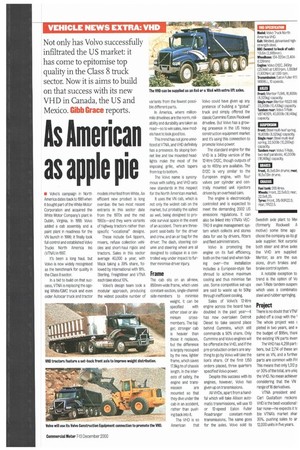As American as apple pie
Page 15

If you've noticed an error in this article please click here to report it so we can fix it.
• Volvo's campaign in North America dates back to 1981when it bought part of the White Motor Corporation and acquired the White Motor Company's plant in Dublin, Virginia. In 1995 Volvo added a cab assembly and a paint plant in readiness for the VN launch in 1996: it finally took full control and established Volvo Trucks North America Inc VTNA) in 1997.
It's been a long haul, but Volvo is now widely recognised as the benchmark for quality in the Class 8 sector.
In a bid to build on that success, VTNA is replacing the ageing White/GMC truck and even older Autocar truck and tractor models inherited from White. An efficient new product is long overdue: the two most recent entrants in this sector date from the 1970s and the mid 1960s—and they were variants of highway tractors rather than specific "vocational" designs.
These include 6x4 tippers, mixers, refuse collection vehicles and short-haul rigids and tractors. Sales in this sector average 40,000 a year, with Mack taking a 39% share, followed by International with 18%. Sterling, Freightliner and VTNA each take about 10%.
Volvo's design team took a modular approach, producing the widest possible number of variants from the fewest possible different parts.
In America, where millionmile drivelines are the norm, reliability and durability are taken as read—so to win sales, new models have to look good too.
This trend has not gone unnoticed at VTNA, and VHD definitely has a presence. Its sloping bonnet line and low mounted headlights make the most of the imposing grille, which tapers from top to bottom.
The Volvo name is synonymous with safety, and VHD sets new standards in this respect for the North American market.
It uses the VN cab, which is not only the widest cab on the market, but probably the safest as well, being designed to provide survival space in the event of an accident. There are threepoint seat-belts for the driver and crew, and an air bag for the driver. The dash, steering column and steering wheel are all designed to collapse in a controlled way under impact to further minimise driver injury.
Frame
The cab sits on an all-new, 850mm-wide frame, which uses constant-section, single-channel side-members to minimise weight. It can be specified with either steel or alu
minium crossmembers. The bigger, stronger cab is heavier than those it replaces, but the difference is largely recouped by the new, lighter frame, which saves 17.9kg/r1 of chassis length. In the interests of safety, the engine and trans
mission are mounted so that they dive under the cab in an accident, rather than pushing back into it.
The VHD is so
Volvo could have given up any pretence of building a "global.' truck and simply offered the dassic Cummins/Eaton/Rockwel driveline. But Volvo has a growing presence in the US heavy construction equipment market and it's using this connection to promote Volvo power.
The standard engine for the VHD is a 3451ip version of the 12-litre D12C, though outputs of up to 465hp are available. The D12C is very similar to the European engine, with four valves per cylinder and centrally mounted unit injectors driven by an overhead cam.
The engine is electronically controlled and is expected to meet the demanding 2002 US emissions regulations. It can also be linked into VTNA's VECTRO II engine management system which collects and stores data for use by drivers, fitters and fleet administrators.
Volvo is promoting the engine on its fuel efficiency, both on the road and when ticking over—the installation includes a European-style fan shroud to achieve maximum cooling and thus minimise fan use. Some competitive set-ups are said to waste up to 50hp through inefficient cooling.
Sales of Volvo's 12-litre engine across the board have doubled in the past year—it has now overtaken Detroit Diesel to take second place behind Cummins, which still commands a 50% share. Only Cummins and Volvo engines will be offered in the VHD, and if the pre-production orders are anything to go by Volvo will take the lion's share. Of the first 1150 orders placed, three quarters specified Volvo power.
Despite this success with its engines, however, Volvo has given up on transmissions.
All VHDs, apart from a handful which will take Allison automatic transmissions, will use 10 or 12-speed Eaton Fuller Roadranger constant-mesh transmissions. The same goes for the axles. Volvo sold its Swedish axle plant to Mei (formerly Rockwell A motive) some time ago chose the company as its gl axle supplier. Not surprisi both steer and drive axle: the VHD are supplied Mentor, as are the susl sions, drum brakes and brake control system.
A notable exception to trend is the option of Vo own T-Ride tandem suspeni which uses a combinatio steel and rubber springing.
Project
There is no doubt that VT1V pulled off a coup with the ' The whole project was pleted in two years, and vi the budget of $95m, thanl the existing VN parts inven The VHD has 4,259 part i bers, but 2,714 of these an same as VN, and a further parts are common with FH This means that only 1,312 p or 30% of the total, are uniq the VHD. No mean achiever considering that the VN range of 16 derivatives.
VTNA president and Carl Gustafson reckons VHD is the best vocational 1 bar none—he expects it tc ble VTNA's market shar 30%, pushing sales to ar 12,000 units in five years.








































































































